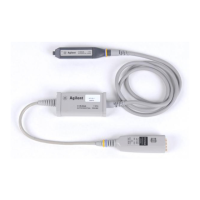4
1159A 1GHz Active Differential Probe
1159A Active Differential Probes Introduction
1159A Active Differential Probes Introduction
The 1159A is a wide-band differential active probe. The probe features low noise,
low input capacitance, high common mode rejection, and Field Effect Transistor
(FET) buffered inputs in the probe head. User-selectable offset gives the probe
flexibility to measure a large range of signal types. Plug-on attenuators and AC
coupling accessories further extend the application range. Included interconnect
accessories allow connection to surface mount and through-hole components
with minimal signal degradation. The input receptacles in the probe head are
compatible with standard 0.025" (0.635 mm) square pins, which provide a
convenient low-cost method of creating device characterization test fixtures.
The 1159A is ideal for acquiring high speed differential signals such as those
found in disk drive read channels, differential LAN, video, and so on. The high
impedance characteristics of both inputs allow you to use the probe as a FET
probe to make single-ended measurements in digital systems without
introducing a ground loop as a conventional FET probe would.
Differential Amplifiers and CMRR
The 1159A Differential Probe is a high input impedance amplifier. A
characteristic of differential amplifiers is the ability to reject signals that are
common to the two inputs. The common mode rejection ratio (CMRR) is the
measurement of this ability. It is expressed as the ratio between the amplitudes
of the common mode and differential signals that produce equal outputs. If the
differential gain is known, these measurements can be referred to the probe
input. CMRR is usually expressed in dB:
The ability to reject common mode signals depends on the balance designed into
the probe amplifier. As the frequency of the common mode signal increases, it
becomes harder to balance the amplifier parasitic parameters. This leads to
degradation of the CMRR.
The CMRR of the 1159A Differential probe is specified from the probe tip. This
method of specifying the probe CMMR eliminates the effects of source
impedance, provided the connections from the probe tip to the signal source are
symmetrical.
CMRR in dB 20
V common mode input Gain×
V common mode output
-------------------------------------------------------------------------
log=
Artisan Technology Group - Quality Instrumentation ... Guaranteed | (888) 88-SOURCE | www.artisantg.com

